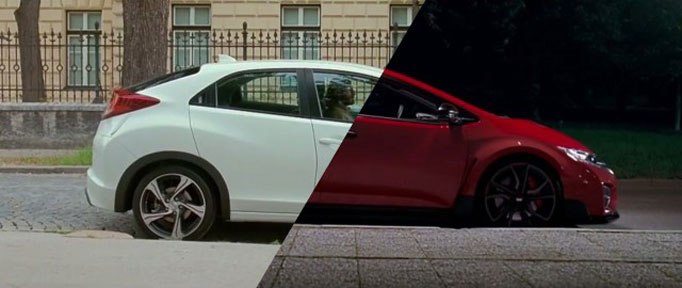Promo Still from the Honda Civic “The Other Side” advert
Its a question asked around boardrooms and planning meetings across the world. How do we make people want to buy our cars? With the marketplace growing more competitive every year, whilst the battle for consumer’s attention becomes more difficult, advertisers have to try harder than ever before. So what makes a great car television advert?
Interactive Advertising
The inspiration for this article came from the new Honda Civic Type R online advert, “The Other Side”. Attracting a lot of attention on its release, the advert allows viewers to switch between a normal, dull school run, and an exciting escape from a bank robbery. To switch between, all the viewer has to do is “Type R” (hold down the R button on the keyboard) and you can switch back and forth.

You can view the advert online here: “The Other Side” – Honda Civic Type R
This advert showcases how advertisers are looking for new ways to engage with its audience. By making the viewer active, it involves them more, so they become more interested in the advert itself. “The Other Side” is just the latest to exploit the power of combining a television advert with web based advertising, a trend that is likely to become more and more popular in the near future. Car television adverts haven’t always been so high tech.
A new way to sell
Car adverts have changed a lot over the decades since television advertising began. The first ever television commercial took place in the United States in 1941, where the test screen clock was replaced with an announcement for Bulova watches. TV advertising really took off in the 1950s as the price of sets became more affordable for homes around the country. Car manufacturers were quick to join in with the trend, taking advantage of a format that could show their cars in action. One of the first marketing methods used was the use of a celebrity announcer, to add prestige and familiarity to a product. This 1957 Mercury commercial from the US has famous game show host and television personality Ed Sullivan presenting. You can see from this advert that the style was focused more on facts and figures, rather than the emotional aspects that modern adverts appeal to.
There was far less competition for ad space back in the 50s, so more longform adverts like this were common. Nowadays, adverts have to get across as much information as possible in a very short period of time. Unless of course, they took the serial format.
Nicole? Papa?
In the early 90s, a new series of adverts from Renault took the country by storm. Portraying a frenchman and his young daughter living life in the beautiful French countryside, the advert was one of the most popular ever, with a survey in 1996 finding the characters of Nicole and Papa more recognisable in the UK than the Prime Minister John Major. Running from 1991 to 1998, Renault had great success throughout the nineties and was named the most persuasive advertiser across five European countries, mainly down to the success of campaigns like this.
The use of continuing characters was not a new development. Getting it right is the hard part and Renault certainly did so. For the final advert, an estimated 23 million viewers tuned in to see who Nicole would marry in the end.
Inspired by the movies
A popular method of engaging with viewers used by advertisers is to reference popular culture, in particular the movies. And no film series has been referenced more than the Bond series. Peugeot took advantage of Bond’s popularity in the 1980s with an action packed advert for the Peugeot 205 GTI. Referencing “The Spy Who Loved Me” and another popular advert series at the time involving the “Milk Tray Man”, Peugeot’s thrilling advert was a big success.
To celebrate the 30th anniversary of the advert, Peugeot updated their advert for the new 208 GTI. Relying more on CGI than clever photography, the new advert has even more crazy action set pieces than before.
The rise of branded content
One of the most popular trends of the 21st century has been the rise of branded content, where a company creates a piece of work that is not an out and out advert, using more subtle techniques to promote their product. Car manufacturers have been one of the pioneers of this type of advertising, having an advantage where all they need to do is have a character in the content drive one of their cars. In the early noughties, BMW hired some top directors including John Woo, Joe Carnahan, Guy Ritchie and Ang Lee to create a series of short films based around the character of the Driver, played by Clive Owen, and his adventures behind the wheel of a BMW. The best short from “The Hire” series belonged to the late great Tony Scott, a director who has never been afraid of embracing advertising style techniques for use in his feature films. His short, titled “Beat The Devil” also included James Brown, Gary Oldman and Marilyn Manson for added star power.
Following release of the series in 2001, sales of BMWs went up 12% from the previous year.
Think outside the box
With more advertising invading our space than ever before, companies have to try harder to grab our attention. So instead of focusing on a typical advert showcasing the car, trying something different has becoming more popular. Whether its Skoda baking a giant car shaped cake, or Mercedes using a chicken to showcase their control technologies, doing something different often leads to positive results. Citroen showcased the benefits of this approach with their dancing robot advert, directed by Neill Blomkamp (District 9 and Elysium).
Three of the best
Advertisers continue to put together some of the most creative, funny and moving content out there. With the amount of time, effort and money they put into getting things right, its no wonder that some people say “the adverts are better than the actual programmes”. Here are three of the best adverts to appear on our television screens.
Audi – “The New Audi R8 V10”
Showcasing the incredible sound of the engine, this Audi R8 advert has an almost visceral quality, helped by its simple idea.
Citroen Picasso – “Robot”
Not even revealing the completed car until the end, this advert takes inspiration from the artist that gave it its name, Picasso. This advert was so successful, customers began asking to have the car with the distinctive Picasso paintwork intact.
Honda – “The Cog”
One of the most iconic adverts of all time, “The Cog” won practically every advertising award around upon its release in 2003. Showcasing a giant “Rude-goldbergesque” sequence, sales of Honda rose by 28% in the UK following its release.
Pitching an advert
To cap things off, one of the best examples of the thinking behind advertising came from the television show “Mad Men”. Don Draper pitches his idea behind a possible new Jaguar advert.
“You must get tired of hearing what a beautiful thing, this car is. But I’ve met a lot of beautiful women in my life and, despite their protestations – they never tire of hearing it. But when deep beauty is encountered, it arouses deep emotions; because it creates desire. Because it is by nature unattainable.
“We’re taught to think, function was all that matters. But we have this natural longing for this other thing.
“When I was driving the E-Type, I passed a ten year old boy in the back window of a station wagon, and I watched his eyes follow. He had just seen something he would want for the rest of his life.
“He had just seen that unattainable object speed by, just out of reach. Because they do that don’t they? Beautiful things?
“Then I thought about a man with sun beams reading Playboy or Esquire and flipping passed the flesh, to the shiny painted curves of this car. There’s no effort to stop his eye. The difference is, he can have a Jaguar.
“Oh, this car. This thing. Gentleman, what price would we pay? What behaviour would we forgive? If they weren’t pretty? If they weren’t temperamental? If they weren’t beyond our reach, out of our control; would we love them like we do? Jaguar. At last. Something beautiful, you can truly own.”
Don Draper, played by Jon Hamm, “Mad Men” Season 5, Episode 11
More from the Creditplus blog:
Top 10 Awesome Car Chases – Ten of the best from the Silver Screen
Top 10 Best Car Related Marketing Stunts – Some of the best publicity campaigns from car companies.





 Facebook
Facebook Twitter
Twitter Instagram
Instagram LinkedIn
LinkedIn Youtube
Youtube